All about balsam

Ornamental plants can be not only trees or shrubs, but also herbs. A striking example is balsam. This culture deserves attention from gardeners.
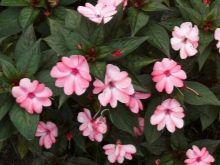
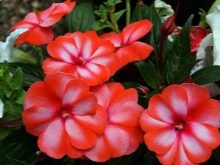

general description
Balsamin, along with scientific, has another name - "Vanka wet". This group includes both annuals and perennials. They are united by the Balzaminov family. It is believed that balsam comes from tropical and subtropical countries. In nature, it inhabits Zanzibar, the continental parts of East Africa.
Some of the species managed to settle in Central Asia. In European states, balsam has been known since 1596. During this time, the plant has become extremely popular in indoor culture. Flowering continues for a very long time. The stems grow straight and can grow up to 0.5 m in height.
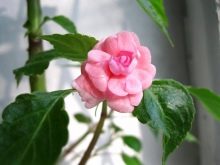
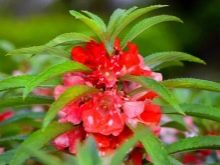

The surface of the stems is juicy and smooth, and they themselves branch out. The length of the leaf ranges from 0.08 to 0.12 m. Lanceolate or oval leaves have serrated edges. They can be painted green or purple-bronze. Flowers develop from the axils of the foliage.
Thanks to the efforts of breeders, a balsam with a double type of flowers appeared. They come in completely different colors, but so far there are no yellow and blue plants. When flowering ends, green fruits are formed. Once they are ripe, a dry boll will appear. It contains a lot of seeds (up to 100 seeds per 0.001 kg).
As soon as you touch the fruit just a little, the box opens. Seeds fly out of the valves. Expansion radius is 2 m.
Balsam is easy to grow, it is characterized by minimal demands on the conditions of detention.
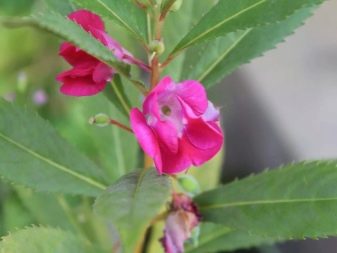
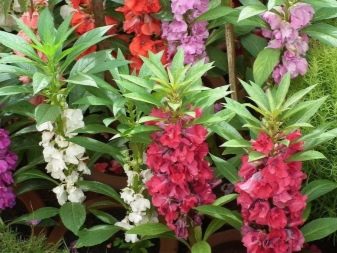
For the first time, balsams (like many other types) were systematized by the famous Carl Linnaeus. However, most of the discoveries were made in the 19th century. And the New Zealand group was generally described by botanists in the late 1980s. Domestic gardeners have mastered Waller's balsam best of all, although other types of it deserve attention. The nickname "Vanka Wet" adopted in Russia is associated with the appearance of small sweetish droplets on the foliage.
In the last century, hybrids bred in New Guinea entered the culture. Now they are in demand by both collectors and flower growers. Some New Guinean species have acclimatized in our country. Moreover, they have become weeds. Those native plants that previously occupied the same position were almost completely displaced.
The attention of gardeners is riveted to balsams largely due to the huge range of geometry and color of the corollas. There are apparently no or almost none of the same species in the vegetation of the entire planet. Flowers are of a simple and double look. You can see on them both a contrasting center of a saturated color, and spots scattered over the petals. The diameter of the flowers on average varies from 0.02 to 0.04 m, but there are also species with larger buds.


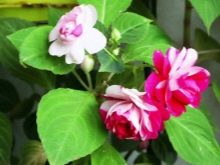
Varieties
Because of its "explosive" character, balsam is often referred to as touchy. Another epithet - "light", is associated with active and long flowering. Different countries (Austria, Great Britain, Germany) have their own specific names. There are 400-550 known species in this family.
How many of them exactly, experts cannot figure out.
Traditionally grown balsams have white or red flowers surrounded by green foliage. Later, hybrids appeared that bloom very profusely. Along with the classic colors, orange and purple tones appeared.There is one more group - Guinean (or rather, New Guinean) hybrids, covered with variegated foliage. It is customary to divide balsam according to the tonality of colors (1 or 2 colors). There are also double flowers.
The terry part is divided into:
- camellia;
- pinkish;
- carnation subgroup.
There are also bushy plants with weak branching. Their height does not exceed 0.4 m. The peculiarity of this group is that the rise of flowers above the leaves imitates a real bouquet. There is a dwarf subtype that grows to a maximum of 0.25 m. Gardeners subdivide plants into indoor and garden varieties.
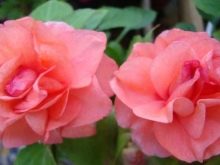
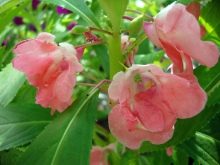
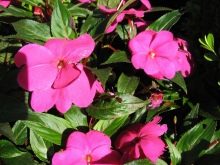
Garden
Balsam originated from the humid tropics. Therefore, in a Russian garden, it can only be grown in an annual form. A perennial group can only give a positive result when grown indoors. Garden "touch-me-not" is a very specific variety, the origin of which is associated with the south of Asia. India, the south of China, and the Malay Peninsula are considered its homeland on an equal basis.
Garden balsam is shaped like a pyramid or a ball. Their height reaches 0.7 m. Shrubs are abundantly covered with foliage. It develops from the leaf sinuses. This species is in dire need of warmth.
Seedlings can be planted in free land no earlier than the second half of June. Under favorable conditions, flowering continues in July, August and September.
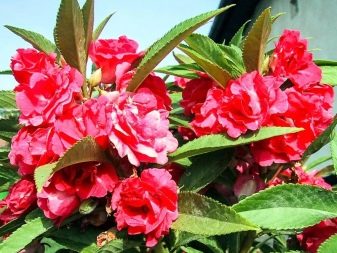
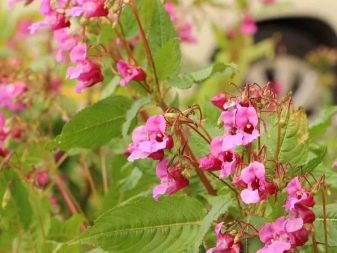
New Guinea species are line-leaved balsam and Hawker's balsam. Such plants can grow up to 1.5 m. Flowering lasts a very long time. The Niamean type (originating from Africa) has original petals in two colors. It reaches a height of 1 m.
Iron-bearing balsam comes from the Himalayan mountains. It is a branched bush up to 2 m high. Large foliage similar to umbrellas forms on it. The name of the species is associated with special glands located at the base of the plate of each leaf.
The Peters species can be represented by shrubs of very different heights, but it is rarely used as a garden one.

Room
In room culture, Waller's balsam is in demand. On its basis, the development of varieties (both pure and hybrids) is continuously being carried out. There are very small homogeneous subspecies (such as the "Symphony" cultivar). As for the New Zealand species, it should winter in a room where the temperature should be maintained at no more than 16 degrees Celsius.
Better suited for growing at home varieties:
- Super Elfin;
- "Futura";
- "Novette";
- "King Kong".
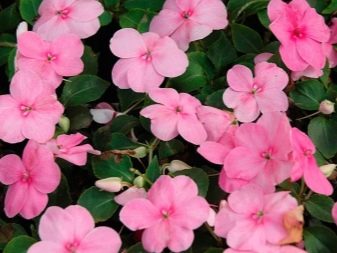
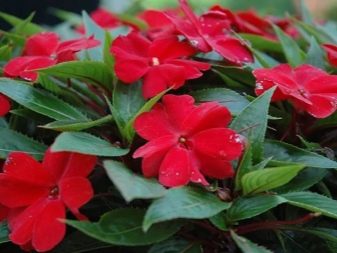
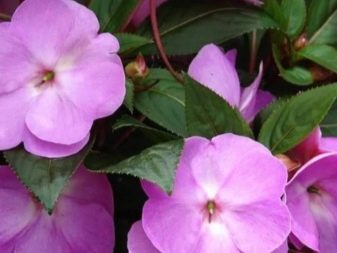
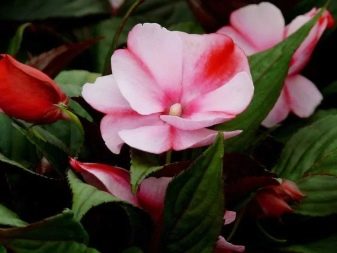
Popular varieties
Originating from Southeast Asia "Camellia" extremely popular among Russian gardeners. It is this variety that is called "wet" more often than others, since the characteristic sugary drops appear from excess water during watering or shortly before a thunderstorm. In culture, this plant has a straight pyramidal shape.
The thick stem is abundantly filled with sap and can grow up to 0.5 m. The flowers can be pink, lilac, white or purple in color. In appearance, the flowers are similar to the lights of bonfires. The small diameter does not prevent them from looking very beautiful and expressive.

"Baby" is one of the varieties related to Waller's balsam. They are dwarf tropical plants that can grow up to a maximum of 0.2 m. Despite their low overall size, the plant produces large flowers in significant numbers. Its color can be very varied. Among "Baby" there are even two-colored plants. Seeds are used for cultivation. They are planted from the end of February to the last days of March.
Most Baby plants are annuals that require a dive.

Similar to camellias miniature balsam "Tom Tamb". This variety has flowers with a diameter of about 0.07 m. Moreover, the height of even the most developed specimens does not exceed 0.45 m. Sometimes there is a red or lilac color. Flowering begins just 3 months after planting the seeds. It will last, however, not for long - a maximum of 8 weeks.
Tom Tamb appreciates light very much. However, you can also grow it in the shade.The only difference will be in the slowing down of growth and shredding of the organs of the culture.
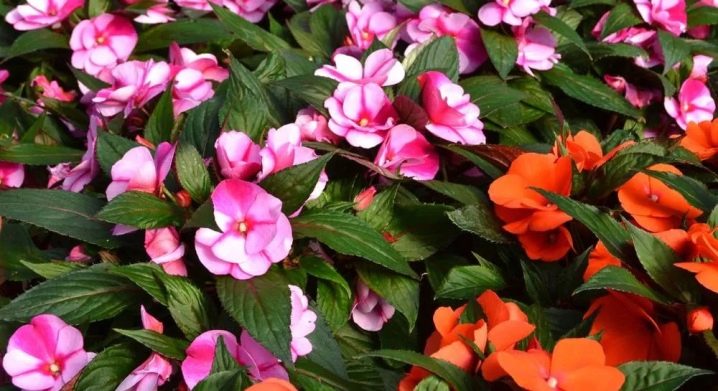
Safari stands out among the annual varieties. Flowering in this variety can continue as long as the weather is warm. He has not only white, pink or red, but also yellow and even coral flowers. The average flower diameter is 0.04 m. According to experienced florists, "Safari" can be used for decorating:
- balcony;
- garden composition in flowerpots;
- rooms.
Sowing seeds is carried out in February or March. You can wait for seedlings in an average of 8-10 days. Seedlings are transplanted into open ground in May.

Balsam "Cutie" forms graceful, relatively small shrubs. Thick leaves cover the trunk, the height of which does not exceed 0.2 m. The abundantly blooming "Cutie" can be useful for growing on the windowsill, and on the balcony, and on the flower bed. The variety is considered light-loving, but can be grown in partial shade. The main thing is that the soil is fertile. "Cutie" can be cut.
Growing from seeds is possible at a temperature of at least 18 degrees.
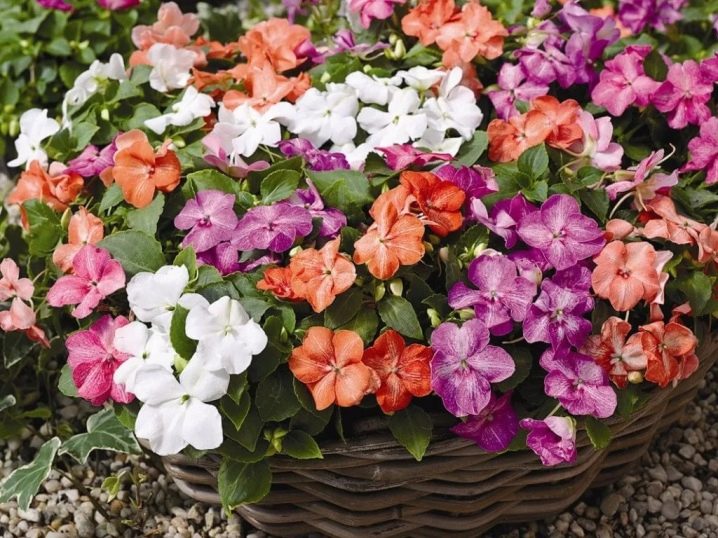
"Strawberries with Cream" is grown on terraces, balconies or free land. The plant is thermophilic. Wintering it requires a strictly defined temperature. Therefore, "Strawberry", with the exception of the warmest regions of Russia, can only be grown at home. A dive is made when three true leaves emerge.
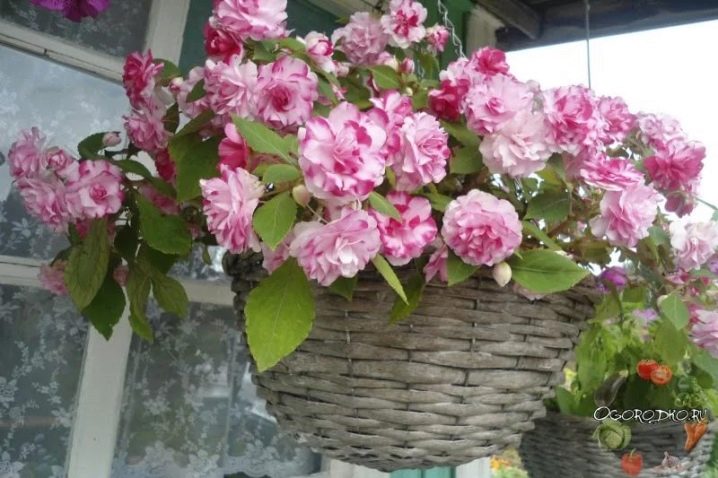
If you really need a low-growing variety, you should pay attention to "Exotic". Basically, this culture, which grows to 0.18-0.2 m, grows on balconies or terraces. It is preferable to orient it to the northwest or northeast. The plant's exactingness to growing conditions is small.
The culture can be grown even with a lack of light, this does not prevent it from blooming vigorously.
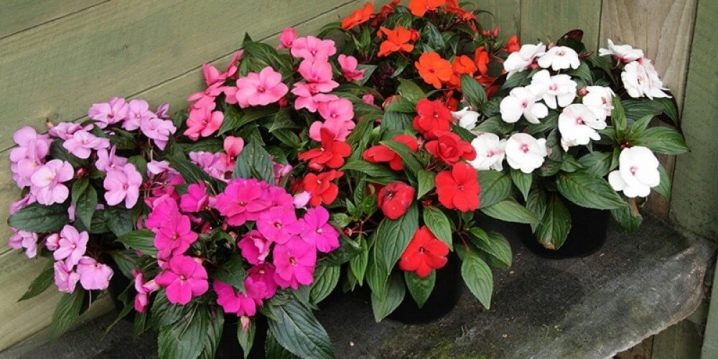
Compact balsam "Kandy" is distinguished by active branching and exuberant flowering, therefore it is perfect as a tapeworm. Its color can be very different. Flowering begins very early and lasts until late autumn. For 7-14 days after planting, you can wait for the first shoots to emerge.
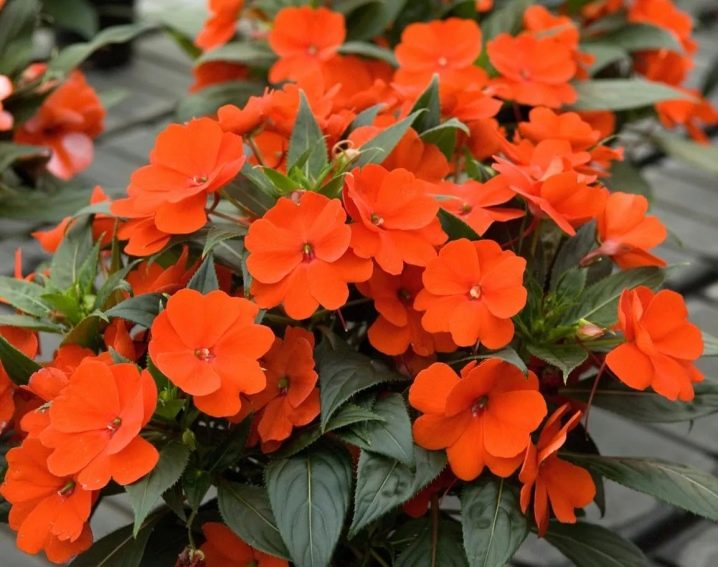
The "Carmelita" variety belongs to annuals and grows to large sizes. The pyramidal culture can decorate absolutely any garden. "Carmelita" is thermophilic and tolerates shade well. Its fleshy stems, however, are fragile. Therefore, you need to handle them as carefully as possible so as not to break. When blooming, large double flowers are formed with a diameter of up to 0.04 m.

"Super Elfin" will also become a smart decoration. A relatively small crop has strong branches. The width of the bush does not exceed 0.35 m. The flowers are bright and rich in color. "Super Elfin" blooms for a long time and actively. Seedlings are planted in the last days of February or during March. Both sunny and partially shaded areas can be used for it.
From one seedling to another, there must be at least 0.15 m.
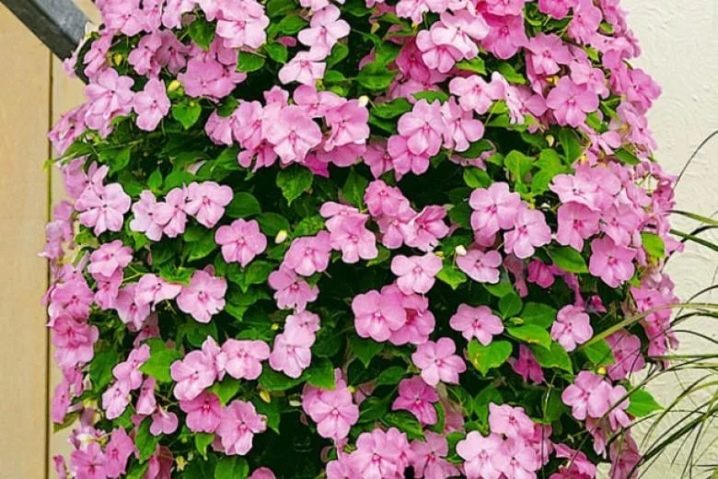
The spherical annual "Eurasia" has a diameter of up to 0.15 m. At the same time, the flower diameter does not exceed 0.06 m. "Eurasia" produces flowers in June, and they can persist until early frost. Like the previous variety, this plant can develop both in the sun and in partial shade. Often "Eurasia" can be seen on a balcony, on a flower bed, and so on. Seedlings can be expected by the end of the third week.
Transplanting to street ground is possible from mid-May.
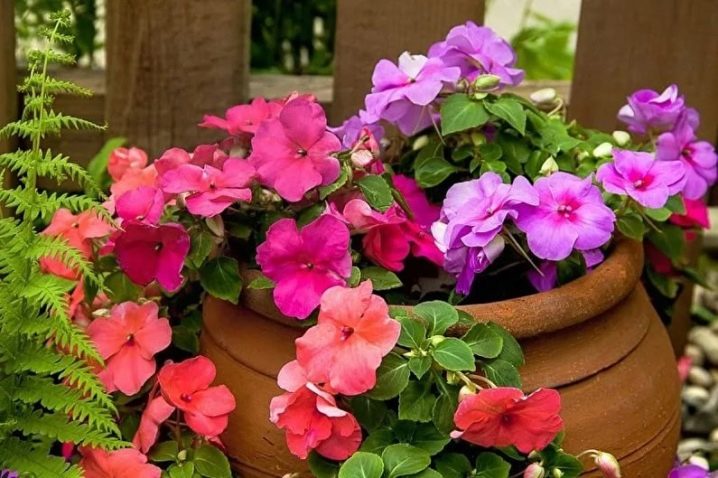
Impreza can also be grown on the balcony. Planting can be done in balcony boxes, but hanging baskets are preferred by some growers. The bushes give dense foliage and grow up to 0.2 m. The delicate pink flowers are distinguished by the spotting of the lower petals. "Impreza" should be planted at a temperature of 18 degrees and above. It takes about 15 days to wait for the first shoots to appear.

Balsam "Lollipop" looks very unusual. This is a highly branching variety of ampelous culture. The diameter of the bush is sometimes 0.4 m. Flowering continues actively and for a long time.Large open flowers are up to 0.05 m in diameter.
The common name for "Lollipopa" is "Purple Star". The unusual looking petals are comparatively thin. Seedlings should be planted in March. In the open land, seedlings should be transplanted in the last days of May. Balance Mix produces small, neat looking bushes. Their height is a maximum of 0.2 m (with a width of 0.25 m). Balance Mix is often grown in a pot or container in the garden. This variety is characterized by a significant variety of tonalities.
If conditions are favorable, you can get very lush bushes, strewn with flowers from top to bottom. Pulling out during transplantation is completely excluded.
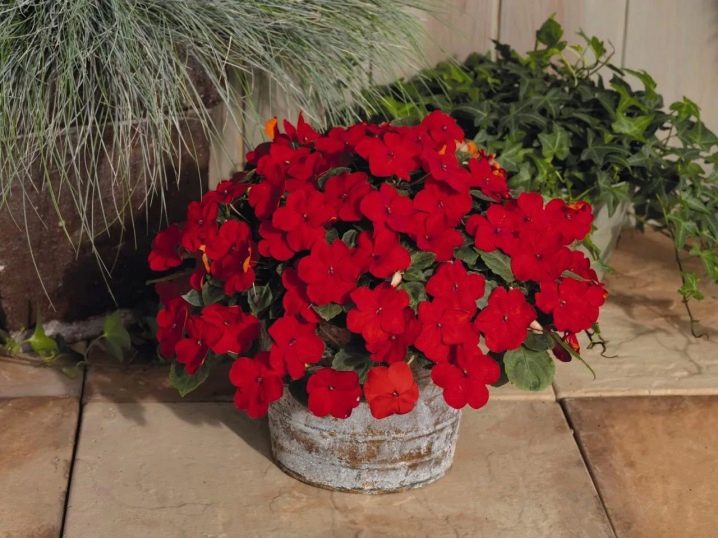
Some growers successfully grow Balance Mix in hanging baskets. You can combine these plants with:
- marigolds;
- petunia;
- cineraria;
- coleus.
An attractive composition can also be created in the shade. Sowing seeds is carried out in March, placing them near the surface of the soil. The reservoir should be covered with foil and protected from direct sunlight. As soon as the sprouts reach 0.01 m, they must be dived. After planting, they are hardened.
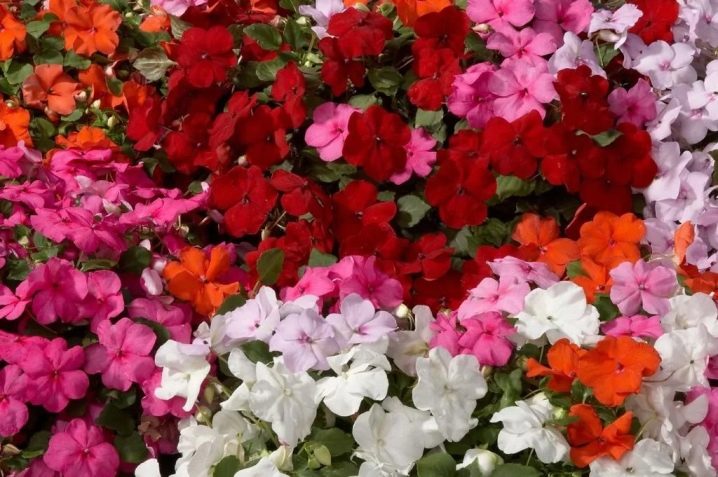
"Cherry splash" is one of the varieties of "Impreza". The height of the culture varies from 0.15 to 0.2 m. The plant develops well in shady areas and forms short internodes. The compact flowers are numerous and appear early. The bush can reach 0.35 m with a flower diameter of 0.04 m.
"Cherry splash" is perfect for breeding seedlings.
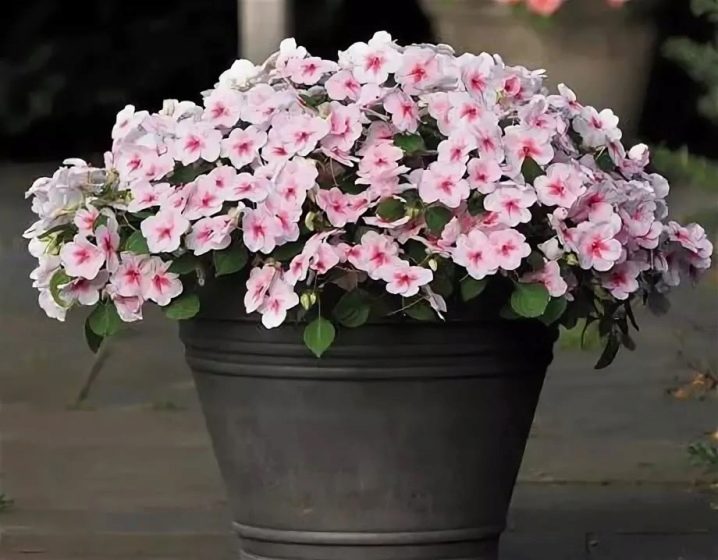
As for the "Accent" variety, it is considered by many gardeners to be almost the best among its kind. The plant can bloom vigorously even on northern windows. The problem is that flower stars aren't always as neat and clear as in promotional photos. Some flowers may be just red at first. But sooner or later, the same ideal buds will still be obtained. You just have to wait. Regardless of the color of the flowers, their diameter will be 0.045 m.
In any case, the plants look attractive, even if the shape is not completely kept.
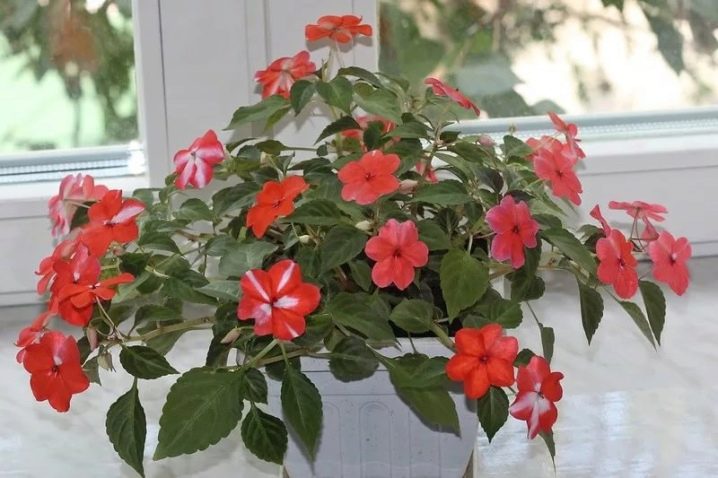
Vienna Waltz is another attractive hybrid balsam of the dwarf range. Miniature bushes have a vintage look and can thrive on shaded ground. The stems are juicy and can decorate both a hanging basket and a flower bed. "Vienna Waltz" can be combined with other summer cultures, but it looks beautiful on its own. Seedlings should be planted in February or March.
When laying them, embedding them in the ground is almost not required. The plant loves warmth and moisture, but too much water is harmful to it. A mass of emerald foliage develops on the stems.

Imperia, which is famous for its variety of colors, may turn out to be no less attractive choice. The height of the culture is from 0.15 to 0.2 m, with a flower diameter of 0.04-0.05 m. "Empire" is good in that it bushes vigorously and can stretch internodes. Therefore, the plants will not stretch. They will also bloom continuously from the beginning to the end of the season. Little of, the variety is also recommended for container growing.
Balsams of this type easily tolerate dense partial shade, sometimes forming flowers much brighter than in the sun.
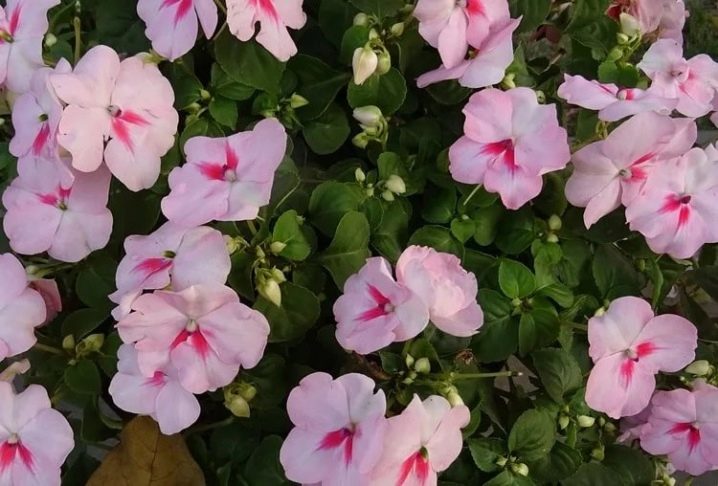
Landing
The basic information on how exactly to plant balsam does not depend too much on the specific variety. In any case, this species is quite easy to breed on the site or inside the house. After sowing, the seeds should be sprinkled with soil quite a bit. It is generally recommended to keep containers in warm, dark areas.... You can remove them from there only when shoots appear.
Illumination is added gradually. The earth must maintain moisture all the time. But at the same time stagnation of water is unacceptable. Always leave holes in the bottom of the container so that excess moisture can escape.

The dive should be carried out in the 3rd week in separate cups. It is recommended to pinch the tops, then the branching will accelerate and more compact bushes will form. You can avoid root breakage when pinching if you take a fork, a toothpick. From planting seedlings to transplanting them into free soil, a suitable fertilizer must be added every 14 days.
When planning to plant balsam on a flower bed, it is necessary to harden it in advance. Sometimes the boxes are taken out in the morning under the blossoming trees. By evening they will have to be brought back. The optimal landing time is from the end of April, so that frosts are no longer dangerous.
Usually, the middle root is cut off by 1/3 first. The distance between the balsams in one row is 0.3-0.35 m. If the distance is less, the plants will "clog" each other and will not be able to grow normally. You can expect the appearance of early flowers in a flower bed by half of summer. Fresh buds can appear until the end of autumn.
It is not necessary to use seeds, cuttings are also good. They are cooked from April to October, and they are taken strictly from the side branches. In order for the cuttings to take root, they are placed in a container with water, after having plucked the leaves below. After rooting, the seedlings are moved one by one into pots with moist soil. There they should be kept in a moderately lit window. Having noticed the beginning of growth, you can take care of the seedlings in the same way as for adult specimens.

Growing
Watering
A complete home care for balsam involves moderate hydration. Water is important to him. If the plant is overdried, the lower leaves may fall off. In summer, the soil inside the pot should always be moistened without waiting to dry to its full depth. During the winter months, excess liquid is unacceptable - it can lead to rotting.
In spring and summer, balsam should be irrigated every other day. To keep the soil moist for longer, use pots with deep trays. With the onset of cold weather, the intervals between watering should be increased to 3 days. But at the same time, they also take into account how dry the earth is. You can take care of the plant only when using prepared water.
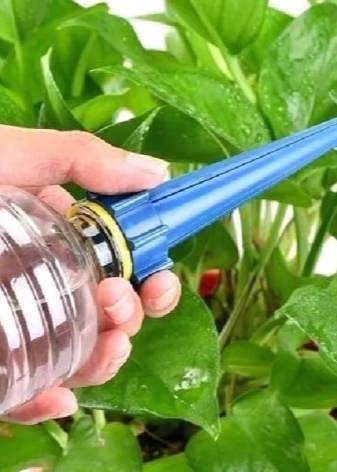
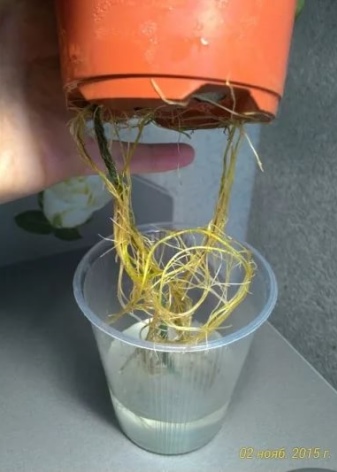
It can be not only boiled, but also simply taken from the water supply. However, in the second case, it is defended for several days. The need for spraying arises if the air is warmed up to more than 22 degrees. When the temperature is at or below this mark, just keep an eye on the soil in the pots. Balsam growing in a flower bed it is necessary to water at the same time as spraying.
This method allows you to exclude pest infestation of the plant. It is especially effective against spider mites. Watering the land on the street should be done, of course, also in a timely manner.
It is recommended to do it in the evening. At night, when it is cool, less moisture will evaporate, so more of it will be absorbed into the ground.
Top dressing
It is possible to grow balsam only if it is properly fed. Once a decade, he needs to be given mineral mixtures. When buds are formed and flowering occurs, nitrogen compounds cannot be used. But the combination of phosphorus and potassium will be very useful. In autumn and especially in winter, feeding is not carried out. You can not feed both diseased and newly transplanted plants.
From transplanting to applying fertilizers, a minimum of 20 days must pass. Balsam blooming in winter should also be fertilized. This is done after bud formation. The best feeding in such a situation will be an unsaturated mineral solution. No fertilizer should be applied on sunny days, as this will provoke a root burn.
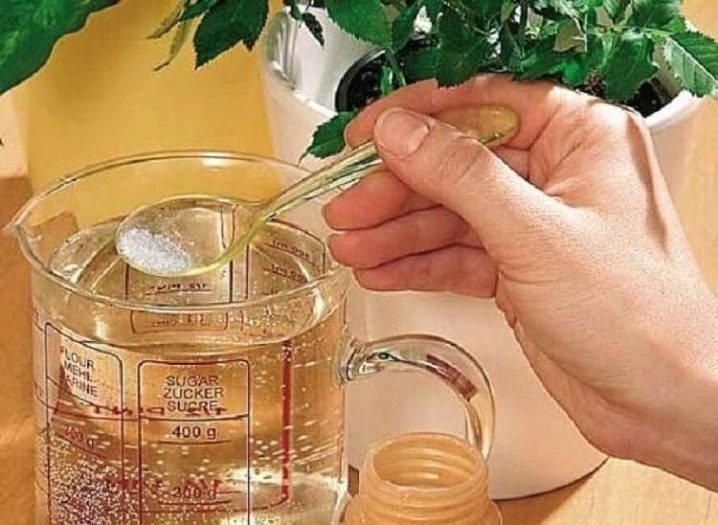
Pruning
The need to trim the balsam is associated with improving the appearance of the bush. Overly long branches should be cut during the spring months. This needs to be done in several steps. Otherwise, the impatience will be very stressed. As already stated, the tops and ends of the shoots should be pinched to strengthen the branching.
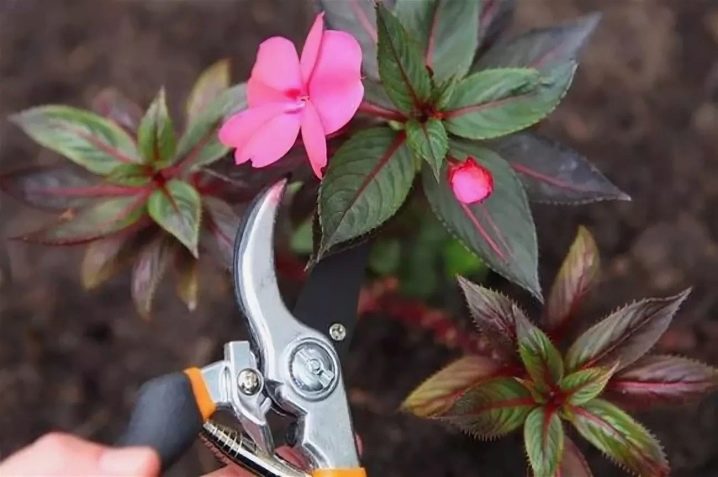
Spraying
This procedure (foliar fertilization) works especially well for young cuttings. Mixture should be diluted in strict accordance with the instructions. Water for dilution is taken only well-settled and be sure to check if it is too hard. The temperature of the liquid should be 2-3 degrees higher than that of the air in the room. Usually alternate nitrogen and phosphorus additives.
There are usually no particular difficulties with the choice of fertilizers for balsam. But complex mixtures for decorative flowers can be considered the best option. According to some growers, the same compositions may be suitable as for geraniums, begonias or violets.
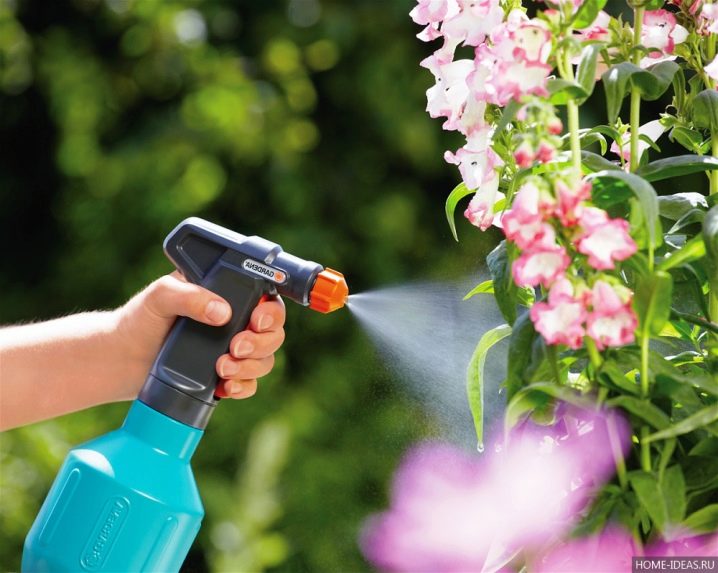
When spraying balsam, a paper screen must be exposed. It will prevent the water from coming into contact with the flowers. The gross mistake is the use of manure and any other organic matter. Instead of a flower exuding a sweet aroma, you can see deflated leaves and crumbling buds. If limescale appears, stop watering with hard water immediately.
Diseases and pests
Proper care can prevent many problems when growing balsam. However, one must also remember about measures to combat ailments and dangerous insects. Root rot can be defeated early by getting rid of diseased roots. For complete success, it is worth transplanting the flower into clean land with high-quality drainage. To exclude the defeat of balsam with gray rot, it is necessary strictly observe the growing conditions.
If the disease does appear, it is necessary to transplant the plant without hesitation. In a new pot, a layer of expanded clay must be made. After transplantation, the culture is watered with "Fitosporin" or another fungicide.
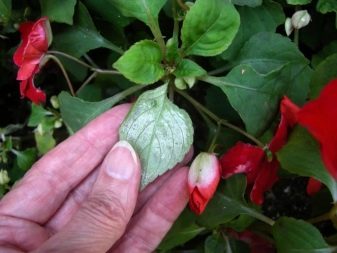
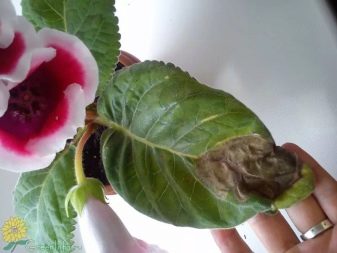

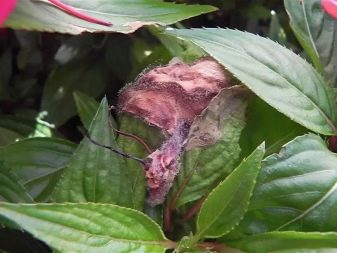
Powdery mildew appears 3-4 days after infection. You need immediately:
- stop watering;
- get rid of infected parts;
- use special drugs until complete recovery.
As for the infection with bacteriosis, it is getting worse - no treatment is possible. It is imperative to eliminate the diseased balsam, otherwise the infection will spread. The same is done when infected with bronze. As for aphids, the fight against it is carried out according to the standard scheme.
If the plant suffers from sciarids, all that remains is to transplant the plant into new soil without over-irrigating it.
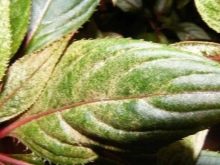

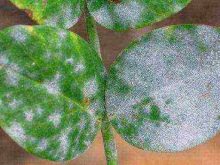
The parasites themselves are driven out by bathing balsam in a strong soapy solution for 5 minutes. This treatment is repeated at intervals of 7 days until success is achieved. If the infection is very strong, apply:
- Actellik;
- Fitoverm;
- Aktar and other suitable insecticides.
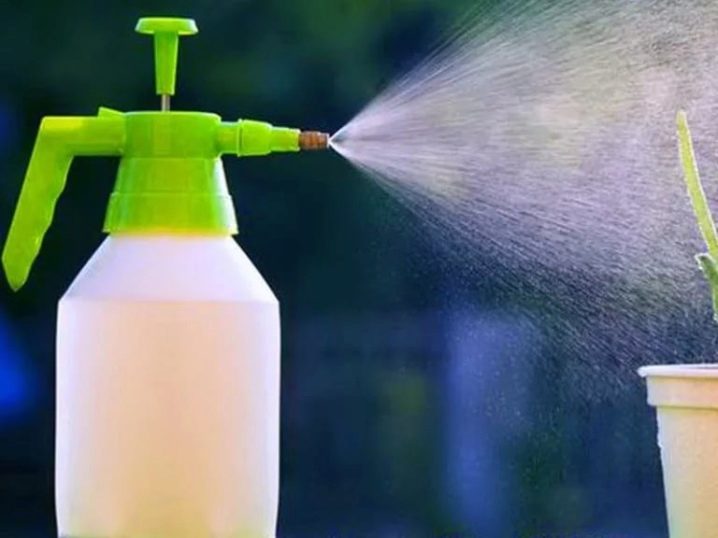
For information on how to properly grow balsam, see the next video.































The comment was sent successfully.